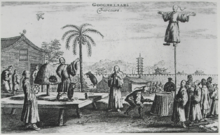
A working rat is any rat which is trained for specific tasks as a working animal. In many cases, working rats are domesticated brown rats. However, other species, notably the Gambian pouched rat, have also been trained to assist humans.
Domesticated brown rats as working animals
[edit]Pet rats derived from Rattus norvegicus, such as fancy rats and laboratory rats, have been trained for various jobs:
Forensics
[edit]In the Netherlands, police have begun using brown rats to sniff out gunshot residue. Ed Kraszewski, spokesman for the task force, has said that the rats are easier and cheaper to train than dogs.[1][2]
Entertainment
[edit]
Rats have been trained to appear in magic acts, music videos, movies, and television shows.[4] Samantha Martin, a professional animal trainer, has claimed that rats are one of the easiest animals to train due to their adaptability, intelligence, and focus.[5]
Laying computer link cable
[edit]By being trained to carry a string through holes in walls, a rat can help economically wire a building for the Internet; afterwards, people use the string to pull the computer link cable through.[6]
As therapy and assistance animals
[edit]Domestic rats are used as therapy animals for children with developmental disabilities. Their small size may be less threatening to some children, and therapy centers with limited space can easily house a few rats.[7]
Domestic rats have been trained as service animals, such as to identify damaging muscle spasms for people whose ability to sense this has been compromised by their disability;[8][9] domesticated rats can be more useful than service dogs for purposes such as these due to their small size and lack of aggression.[10][11]
Gambian pouched rats as working animals
[edit]A Belgian non-government organization, APOPO, trains Gambian pouched rats (Cricetomys gambianus) to sniff out land mines and tuberculosis. The trained pouched rats are called HeroRATS. Hundreds of thousands of people worldwide commit to "adopt" rats and pay to support them.
References
[edit]- ^ Dutch cops are using brown rats to solve crimes. The Associated Press. Thursday, September 5, 2013. [1] (Retrieved on 2013-10-23)
- ^ Ratten helpen politie met sporenonderzoek. Nederlandse Publieke Omroep. 5 september 2013. (Retrieved on 2013-10-23)
- ^ Lach, Donald F.; Van Kley, Edwin J. (1994), Asia in the Making of Europe, Chicago: University of Chicago Press, ISBN 978-0-226-46734-4. Volume III, "A Century of Advance", Book Four, "East Asia". Plate 364. In the caption, Lach and van Kleyn identify the performing animals as mice and rats.
- ^ Hare, David. (2003-2-27) The Rat Lady: A day in the life of Cathe Boudreau Alleger Las Vegas City Life. (Retrieved on 2009-3-10)
- ^ Wilson, Stacy Lynne (April 20, 2007). "Samantha Martin: Exclusive Interview". Animal Movies Guide. Running Free Press. pp. 365–366. ISBN 978-0-9675185-3-4.
- ^ Irvine, Martha. (1997-10-11) A Rat's Trail Rattie helps wire computer systems by going where no person can. The Kansas City Star, Page E3.
- ^ Panchak, Pam. (2008-6-12) Rats are bringing out best in kids with autism. Pittsburgh Post-Gazette. (Retrieved on 2009-3-8)
- ^ Peter Day (2010-8-15) Change in ADA regulations concerns local service-animal owners. Victorville Daily Press. (Retrieved on 2010-8-18) Archived copy: [2] (Retrieved on 2018-10-5)
- ^ Bethany Barnes Arizona. Arizona clamping down on service animals. Sonora News Service, Apr 2, 2013 [3] (Retrieved on 2018-10-5)
- ^ U.S. Department of Justice, Civil Rights Division. ADA Requirements: Service Animals. [4] (Retrieved on 2018-10-5)
- ^ AP Archive. Published on 30 Jul 2015 Hiyo Silver the rat helps owner cope with medical condition. [5] (Retrieved on 2018-10-5)